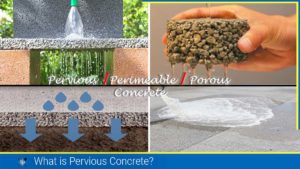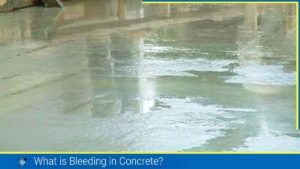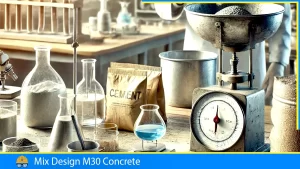What is Cellular Concrete?
Cellular concrete, also known as aerated or foamed concrete, is a lightweight building material that is made by mixing cement (Portland cement), water, and a foaming agent. The foaming agent produces bubbles in the mixture, which creates a cellular structure when the concrete sets. Such concrete has a lower density than traditional concrete, making it lighter and more easily workable.
The material is easy to work with and can be cut, drilled, and shaped with conventional tools. It is a suitable material for construction projects that require weight reduction and thermal insulation. Foamed concrete can be employed in numerous applications, such as filling cavities, floor and roof insulation, prefabricated building elements, and more. Cellular concrete has a compressive strength of 1 N/mm2 to 15 N/mm2, making it versatile for a wide range of applications.
The preformed foam used in this type of concrete serves to introduce a significant amount of stable air voids into the mixture, which results in the formation of a porous or cellular solid upon curing and hardening. It can be produced in different densities, ranging from ultra-lightweight to higher densities that can be used for structural purposes. Thus, the dry density of 400 kg/m3 to 1800 kg/m3 or less, when hardened, is achieved.
Materials for Cellular Concrete
The materials used for production may vary depending on the specific application, however, cement, foam and water are the key ingredient used to produce it.
Cement: Ordinary Portland cement (OPC) or blended cement (such as Portland slag cement or Portland pozzolana cement) are used in cellular concrete production. OPC is the most commonly used cement due to its availability and relatively low cost. Blended cement may also be used to improve its properties of it, such as its compressive strength or durability. The amount of cement used in the mixture can also affect the properties of the cellular concrete, including its strength, density, and workability. It is crucial to maintain the water-cement ratio while preparing the mix.
Water: A portable water that is fit for drinking can be used for the mixing of concrete. The quality of water used can have an impact on the final properties of the cellular concrete, including its strength and durability. Therefore, it’s important to use water that is free of contaminants and impurities that could negatively affect the performance of the material. Additionally, the amount of water used in the mixture can also impact the properties of the cellular concrete, including its density and compressive strength.
Fly Ash: Fly ash is a by-product and its disposal is very expensive. It is used in the preparation of cellular lightweight concrete. It is one of the key ingredients which resolves the issue of disposal and at the same time, it’s very economical making it environmentally friendly.
Foam: Foam is an essential ingredient in the production of cellular concrete as it helps to introduce a high proportion of stable air voids into the mixture. These voids create a porous solid structure upon curing, resulting in a lightweight material with excellent thermal insulation properties. The size of voids or bubbles ranges from 0.1 to 1.5 mm in diameter in cellular concrete. Foam is typically produced by mixing a foaming agent with water and air, which is then mechanically mixed with the cement and aggregate to create the final cellular concrete mixture. The foam is an integral part of the cellular concrete production process, enabling the material to achieve its unique properties and wide range of applications.
Types of Cellular Concrete Based on Density
- High-Density Cellular Concrete
This is a structural grade concrete having a density ranging from 1200 to 1800 kg/m3. It is used in the construction of load-bearing walls, and partition walls and in the production of pre-cast blocks for load-bearing brickwork.
- Medium Density Cellular Concrete
The density ranges from 800-1000 kg/m3. The major use of this type of cellular concrete is found in the manufacturing of pre-cast blocks for non-load-bearing brickwork.
- Light Density Cellular Concrete
Light-density cellular concrete has a density in the range of 400 –600 kg/m3. LDCC is ideal for thermal and sound insulations. They act as a resistance against fire accidents, termites and moisture absorbent. They have also proved to be a better substitute for glass wool, wood wool and Thermocol.
Application:
- Cellular lightweight concrete is utilized as thermal insulation in the form of bricks and blocks over flat roofs or non-loading walls.
- Bulk filling by applying relatively low-strength material for old sewer pipes, wells, unused cellars and basements, storage tanks, tunnels and subways.
- Production of the heat-insulated light wall panel.
- Maintain Acoustical balance of concrete.
- Manufacture cement and plaster-based light plates.
- Production of special light heat-resistant ceramic tiles.
- For soil water drainage purposes.
- Application in the bridge to prevent freezing.
- Utilized for tunnel and shaft filling and lightweight concrete manufacturing.
- Production of Perlite plaster and Perlite lightweight concrete.
Advantages of Cellular Concrete
Cellular concrete offers several advantages over traditional construction materials. Some of the major advantages include:
Lightweight:
Is a lightweight material, which makes it ideal for use in applications where weight reduction is important. It is typically 50-75% lighter than traditional concrete, which can result in significant cost savings in terms of transportation, handling, and installation.
Thermal insulation:
It provides excellent thermal insulation properties with the ρ-value of foamed concrete being slightly higher than that of other insulating materials. Being excellent thermal insulating materials it can help reduce energy consumption and lower heating and cooling costs. This makes it an ideal material for use in construction projects where energy efficiency is a priority.
Fire resistance:
It has excellent fire resistance properties, as it does not burn or emit toxic fumes when exposed to high temperatures. This can help improve the safety of buildings and structures.
Sound insulation:
The cellular structure of such concrete also provides good sound insulation properties, making it ideal for use in projects where noise reduction is important.
Durability:
It has a high resistance to weathering, erosion, and other environmental factors, which makes it a durable and long-lasting material for construction projects.
Easy to work with:
Easy to work with and can be cut, drilled, and shaped with conventional tools. This makes it a versatile material for a wide range of applications.
Environmentally friendly:
Is a sustainable and environmentally friendly material, as it is made from a mix of recycled materials and does not require a lot of energy to produce.
Disadvantages:
While cellular concrete has many advantages, there are also some potential disadvantages to consider. These include:
Cost:
Cellular concrete can be more expensive than traditional concrete due to the cost of the foaming agent and the specialized equipment needed to produce it. However, the lower weight of the material may help offset the higher upfront cost in some applications.
Limited availability:
Cellular concrete may not be readily available in all regions or areas, which can increase transportation costs and lead times.
Strength limitations:
While cellular concrete can be used for structural applications, it may not have the same strength as traditional concrete. Therefore, it may not be suitable for use in high-load-bearing applications.
Set-up time:
The foam used to create cellular concrete can take some time to set up, which can increase the overall production time and potentially delay construction schedules.
Limited application temperature:
The foaming agent used to create cellular concrete may be sensitive to temperature and humidity, which can limit its use in certain climates or conditions.
FAQs:
Q: How does cellular concrete compare to traditional concrete in terms of strength?
Answer: Cellular concrete typically has a lower compressive strength than traditional concrete, ranging from 1 N/mm2 to 15 N/mm2. However, it is still suitable for many applications where weight reduction and thermal insulation are important factors.
Q: What are the common applications of cellular concrete?
Answer: Cellular concrete has a wide range of applications, including insulation, filling voids, flooring, roofing, and prefabricated building blocks. It is also used in geotechnical applications, such as soil stabilization and backfilling.
Q: Is cellular concrete suitable for use in high-load applications such as foundations or retaining walls?
Answer: Cellular concrete may not be suitable for high-load applications such as foundations or retaining walls, as its lower compressive strength may not be able to support the weight and pressure of the structure. However, it can be used as a lightweight fill material in these types of applications.
Q: Can cellular concrete be used in cold climates?
Answer: Yes, cellular concrete is an excellent thermal insulator and can be used in cold climates to help reduce heat loss in buildings and other structures.
Q: How does the cost of cellular concrete compare to traditional concrete?
Answer: The cost of cellular concrete can vary depending on the specific application and local availability of materials. However, it is generally more expensive than traditional concrete due to the additional cost of foam production and mixing equipment. However, the cost may be offset by the material’s lightweight properties, which can reduce transportation and handling costs.
References:
- Just, A., & Middendorf, B. (2009). Microstructure of high-strength foam concrete. Materials Characterization, 60(7), 741-748. https://doi.org/10.1016/j.matchar.2008.12.011
- Foam concrete. (2022, June 2). In Wikipedia. https://en.wikipedia.org/wiki/Foam_concrete
- Cellular concrete in construction. (022 November 01). Designing buildings. https://www.designingbuildings.co.uk/wiki/Cellular_concrete_in_construction
- Raham F. U. (2019, January 07 )What is cellular concrete? Types and materials. The constructor. https://theconstructor.org/concrete/cellular-concrete-types/28732/
- The Constructor. (2019, Jan 7,). Cellular Concrete Types, Features, and Applications. Retrieved April 3, 2023, from https://theconstructor.org/concrete/cellular-concrete-types/28732/
![]()







